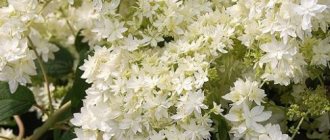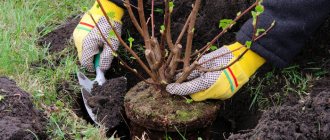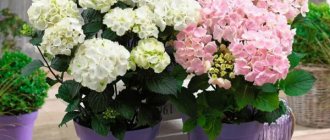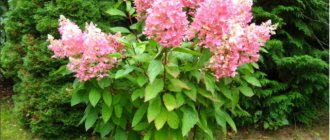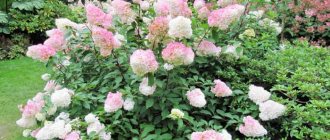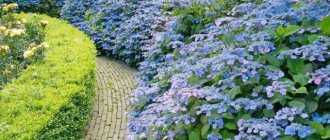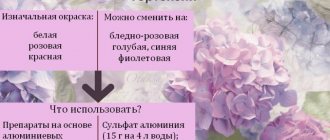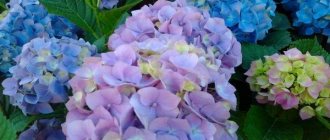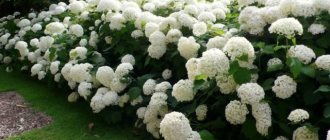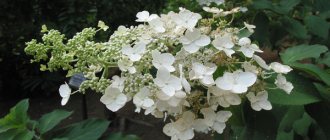Description and characteristics of the variety
Hydrangea (hydrangea) Eternal summer is a perennial frost-resistant beautiful flowering plant that grows no more than 1 meter in height. On erect shoots there are oval leaves of a rich green hue. The ends of the leaf plates are slightly pointed and elongated, and the edges are jagged.
The Eternal Summer variety has lush inflorescences of lilac, blue or pink flowers
Large spherical inflorescences are located at the top of the shoots. The small flowers have a single row of blue, lilac and pink petals. Hydrangea blooms all summer, and new buds bloom to replace the fading buds. Endless summer is a large-leaved hydrangea.
Important! In addition to Endless Summer, the group includes other beautifully flowering varieties: Everlasting Magical Opal, Pink Annabelle, Bloomstar, Twist and Shout. All of their seedlings can be purchased in special nurseries.
Popular varieties
| 1. Endless Summer Twist-n-Shout Description:
Looks great as a tapeworm on the lawn and in compositions. Doesn't like wind. To stimulate flowering, trim off faded inflorescences. | |
| 2. Endless Summer Blushing Bride Description:
Compact bush with strong shoots | |
| 3. Endless Summer Bloom Star Description:
The variety is used to decorate ceremonial places; it looks great as a tapeworm on the lawn and as part of a landscape composition. The variety is resistant to most diseases and pests. Doesn't like the wind |
How and where to plant
Hydrangea Annabelle - planting and caring for the plant in open ground
To grow hydrangeas, you need to choose sunlit areas. However, it is worth considering that the open area should not be blown through by cold winds. Locations near buildings, hedges or tall trees are best.
Planting Hydrangea Summer is carried out as follows:
- All weeds are removed from the dug area with a rake.
- Organic fertilizers are applied: humus, rotted manure, compost.
- Dig holes 3 centimeters deeper than the length of the roots.
- The bottom of each hole is covered with drainage material with a layer of 4-6 centimeters.
- The soil mixture is poured on top of it.
- The wells are moistened with slightly warm water.
- Plant one seedling per hole.
- Sprinkle around with the remaining soil mixture.
After planting, it is necessary to strictly monitor the condition of the seedlings for about half a month. It is recommended to regularly water the soil and mulch the soil with dry leaves or sawdust.
Transplantation after purchase into open ground
Hydrangea Summer Love - description
It is best to transplant hydrangeas on a cool day or just before rain. The weather should be calm, when the sun does not shine very brightly. The best time for planting is April-May or October.
Transplanting a plant
What is needed for planting
Before planting hydrangeas in open ground, it is necessary to carry out a number of mandatory procedures that will reduce the risk of complications. This will also help increase the survival rate of the bushes.
- Dig up the planting area, remove all weeds and roots from other plants.
- If possible, choose the oldest seedlings with closed roots in the nursery, which were planted in a mixture of peat, sand and sawdust.
- Prepare a place for the bush by gradually digging up the soil and adding peat, turf, sand and humus to it in a ratio of 1:1:1:1.
- Dig small holes with a diameter and depth of 50 cm, at the bottom of which lay gravel, crushed stone or crushed brick to prevent excessive moisture.
- Fill the soil generously with water.
For your information! Experienced gardeners recommend adding mineral and organic fertilizers to the planted holes before planting, which contribute to more efficient formation of flower buds.
Choosing the optimal location
The choice of location when planting large-leaved hydrangea of the Endless Summer variety plays a particularly important role. Not only the health and appearance of the shrub itself, but also its ability to survive in the cold season depend on this.
Basic recommendations for selection:
- Lighting. Since any large-leaved variety of hydrangea is light-loving, it is necessary to plant the plant in well-lit areas. It is also impossible to choose an area completely without shade, since the bush will suffer from drying out. The ideal solution is to plant in the soil near a low tree, the shadow of which covers the flower for 6-8 hours a day.
- Temperature. Large-leaf hydrangea can only be planted in warm soil. At the same time, the plant also does not tolerate heat and requires timely shelter. The most favorable temperature in spring is considered to be 10-15 °C.
- Humidity. Young seedlings should be protected in advance from excessively strong winds or frosts. The plant loves well-ventilated places in which air circulates freely. However, you should not plant hydrangea in a draft; the best option is to plant it near a fence or along a facade.
- Priming. The bushes of the plant germinate well in soil with weak or medium acidity (pH 5-5.5). It must be remembered that the soil should not be calcareous, otherwise the root system will often get sick or die altogether.
Since the color of flowers depends on the acidity level of the soil, special attention should also be paid to this when choosing a place for planting. Therefore, if the inflorescences have grown in a different color than expected, there is no need to panic.
Step by step planting process
The next step after preparing and choosing a location is to directly plant the plant in the already prepared soil.
Planting process
To do this, you need to follow step-by-step recommendations:
- Clear the trunk and root system of the seedlings.
- Place the roots in the hole, gently straightening them with your palms.
- Make sure that the root collar remains level with the ground.
- Cover the roots with soil and compact the resulting mound with your hands.
- Water each bush with 18-20 liters of water.
- Mulch with sawdust, coniferous plants or pine bark to a height of 7-8 cm.
Note! Immediately after planting, it is recommended to add organic fertilizers and ensure that the seedlings do not bend.
Shrub care
Hydrangea Polar Bear - description and care of the plant
After planting and caring for the Eternal Summer hydrangea, special attention must be paid. Mistakes made in growing flowering plants immediately affect their ability to bloom buds.
The bush needs to be watered abundantly
Watering
The moisture-loving Endless Summer hydrangea is especially sensitive to soil moisture. The soil should not be allowed to dry out, so it is recommended to mulch the surface of the earth.
Important! You need to water the soil with high-quality water, the temperature of which should be from 18 to 25 degrees.
Top dressing
Hydrangea largeleaf Endless summer needs to be fed twice a month. During the growth of leaf mass, the flower needs nitrogen fertilizers, and with the beginning of flowering - potassium-phosphorus fertilizers.
Trimming
Pruning is a mandatory procedure for caring for hydrangea. It is carried out in the fall, rotten and dry shoots are removed at the root. If the bush is more than 4-5 years old, then you need to cut off the old branches so that the bush is renewed.
Landing
Large-leaved hydrangea variety Endless Summer has several advantages over other varieties:
- frost resistance: plants can survive cold spells down to -30°C;
- flowering observed in spring and summer, so this period is 3 months longer than other varieties.
Planting hydrangeas must be done in the right place and under certain conditions. If you carry out the procedure, adhering to all the recommendations, then by next year you will be able to enjoy beautiful flowering bushes.
Important! Basic rule: at noon, the hydrangea should be in the shade for 2
–
3 hours. If this is not done, the bushes will quickly dry out.
Selecting a location
It is very important to choose the right place for planting. If you plant planting material in the northern part of the site, then you need to do it in open areas. Plants must receive sufficient solar heat and lighting.
Planting on the south side of the garden requires protecting the bushes from direct sunlight. The soil for planting should be nutritious, but with an average level of acid and alkali (from 5 to 7.5). The distance between the bushes should be such that they do not touch each other.
Soil preparation
The soil should be moistened, but not too much, so a month before the proposed planting (it can be done in spring and autumn), you need to dig up the area and apply fertilizer (humus or peat). 4 buckets of nutrients are scattered per 1 m². After this, water the soil with water at the rate of 50 liters per 1 m².
You need to mark the area a week before planting. Holes measuring 50x50 cm are dug at a distance of 2 m from each other. If groundwater comes closer than 2 m to the ground, then a drainage system must be installed. For this, expanded clay or crushed stone is used. The drainage layer should be about 20 cm.
Read: description and cultivation of Baby Lace hydrangea.
Planting process
The planting technology is as follows:
- Sprinkle the drainage layer with nutritious soil. To do this, mix garden soil with peat (in a ratio of 2:1) and add 100 g of superphosphate.
- Place the seedling inside the hole and distribute the roots.
- Dig a metal rod nearby, 30 cm long above the seedling. Tie a plant to it.
- Cover the hole with soil and pour in 30 liters of water.
- Compact the soil to prevent voids from forming in the root system.
- Mulch with a 20-centimeter layer of humus or peat.
Propagation of hydrangea Endless Summer
Any cultivation of ornamental plants is not complete without their reproduction. Hydrangeas are mainly propagated only using cuttings. The bush whose shoots are pruned must be older than 3 years.
Hydrangea Hot Red - variety description, planting and care
Description of the flower propagation procedure step by step:
- The lower leaf plates are removed from the cuttings, but at least 3 leaves are left on top.
- Then the box is filled with substrate and the cut shoots are planted along its edge.
- The top of the container is covered with film for a greenhouse effect.
- Water the cuttings twice a week until they take root.
Note! Large-leaved varieties of hydrangea are practically not propagated by seeds; this method is used only by breeders.
Growing and care
When choosing a site for planting a plant, you need to remember that it requires light, but also tolerates partial shade. Afraid of gusty winds and direct hot sunlight. Therefore , it is desirable that the sun illuminates the plantings only in the morning and afternoon .
The bush is placed on a flat surface or a slight elevation to avoid excess accumulation of water at the roots. The soil for planting should be acidic or slightly acidic. As an example, one of the compositions: turf and leaf soil, peat and sand - all in equal parts.
Important! Calcareous soil is not suitable for hydrangeas!
How to plant?
When planting, you should adhere to the following recommendations:
- the selected area is dug up, removing weeds and rhizomes;
- compost, turf, humus or peat are added to the soil;
- dig a hole (diameter and height 50 cm);
- drainage made of small pebbles, gravel or brick chips is placed at the bottom;
- the soil is shed abundantly with water;
- the roots are placed in the hole, carefully straightened;
- fall asleep with the nutrient mixture, lightly compacting;
- water abundantly;
- mulch, retreating from the shoot by 8–15 cm.
The mulch layer is about 8 cm and consists of fallen pine needles or crushed bark, sawdust or compost.
Watering
The bush loves moisture, but not excess. For several weeks after planting, carefully monitor the soil, which should not dry out.
Watering is done in the morning or evening. It needs to be regular. An adult plant requires two buckets of liquid per week. Rainwater is used. Tap water must be left to stand and slightly acidified with lemon juice or vinegar. In dry summers, abundant watering is necessary.
Reference! To avoid chlorosis, it is recommended to moisten the soil with a solution of salts containing iron (once every 10 days).
Top dressing
The plant needs feeding with both organic and mineral fertilizers. It should be noted that frequent application of nutrients leads to an increase in the green mass of the bush to the detriment of flowering. It is enough to administer supplements up to twice a month. Complex preparations with a high potassium content, as well as superphosphate, are useful.
Hydrangea cannot be fertilized with ash!
Trimming
In the first years, pruning is not recommended. As the bush matures, broken, dry and old stems are shortened in the fall.
A small forming is done carefully. Dried inflorescences are trimmed to the first bud. The remaining branches are not shortened much. To enhance growth and abundant flowering, carry out regular spring pruning. Aging bushes are rejuvenated by removing branches to perennial wood or “stumps.”
Reproduction
The plant is propagated by cuttings, which are cut with 1–2 internodes and placed in a substrate (2 parts peat and 1 part sand). The leaf blade is shortened by half. Rooting lasts 20–25 days.
When propagated by seeds, they do not need to be placed in cold greenhouses or in boxes under glass.
Preparing for winter
- Before frost, the plants are covered with peat at the base. The soil is covered with a cordon, plywood or boards, on which the lashes are carefully tilted and laid. The branches are covered in two layers with spunbond, lutrasil or greenhouse film, spruce branches, and covered with dry leaves.
- With the arrival of spring warmth, the shelter must be removed to avoid damping out. Where the temperature is negative at night, the bushes are gradually freed from covering material. The branches are not lifted, they straighten themselves. Frostbitten shoots are cut out completely.
Pests and diseases
Hydrangea Endless Summer is one of the few flower varieties that is immune to a disease called powdery mildew. But a false version of this disease often affects ornamental bushes. A whitish coating forms on the leaf blades, which inhibits the normal development of the plant. To combat this, drugs containing copper are used.
For your information! A well-known folk remedy for downy mildew is treatment with copper sulfate.
Bush diseases
Chlorosis is another disease that can affect the bush. The leaf blades begin to fade as the process of chlorophyll formation in the cells is disrupted.
The causes of this disease may be:
- lack of natural light, so necessary for photosynthesis and the formation of chlorophyll;
- low-quality irrigation water: hard tap water, with a high alkali content;
- elevated temperatures, prolonged dry periods.
To get rid of chlorosis, the plant is sprayed with a solution of iron sulfate, and the soil is also treated with it.
Spider mites are among the pests of Endless Summer. These are small insects that are located on the underside of leaves and weave a thin web. Parasites eat the succulent parts of leaves and stems, which causes the bush to stop developing and flowering.
Note! To control pests, special chemicals are usually used - insecticides, but spider mites must be destroyed with acaricides.
The flower pleases its owners by blooming until the end of summer
Hydrangea Eternal Summer is a variety that blooms with double blue, pink and purple inflorescences. This is a unique flower, which, despite its external fragility, is highly resistant to cold and disease. If you take care of it regularly and in a timely manner, it will not cause any trouble and will delight you with its beautiful flowering until the end of summer.
XXI CENTURY Candy Fudge Scented water
266 ₽ More details
Video baby monitor Motorola MBP36S (white)
12900 ₽ More details
Fashionable jeans 2020-2021 for women
Hydrangea Paniculata Summer Love paniculata: description
The key characteristic of the variety is its compact crown, which can be formed into a bush up to 1.5 m high or a tree up to 3 m high. The gardener decides exactly what form the plant will take from the very beginning, carrying out systematic pruning in subsequent years.
A bush planted in spring blooms the same year. Withstands winters with frosts down to −35°C. The branches do not resist the scorching sun and strong winds well, so they need quiet shelter from the midday heat and gusts of wind.
Hydrangea Paniculata Summer Love
Origin and appearance of hydrangea Summer Love
Under natural conditions, the shrub is found on Sakhalin, Japan and China. The ancestor of the Summer Love variety is capable of reaching 10 m in height; cultivated varieties are much more modest in size. The roots predominantly spread in breadth, covering an area significantly larger than the diameter of the crown.
Hydrangeas in the garden
All hydrangeas have leaves that are rich green in color and ovoid in shape. In the Summer Love variety it is up to 12 cm in length. It is considered a good honey plant. After the flowers wither, fruits are formed - boxes containing numerous very small seeds.
For your information! It is unknown exactly how long a bush or tree can live in one place, but specimens whose age exceeded 60 years have been recorded.
How the Summer Love hydrangea blooms
The inflorescences are very dense, pyramid-shaped, up to 35 cm long, with a rounded tip. The first flowering usually starts in mid-summer and is snow-white. The second occurs three weeks later and is already soft pink, and the third begins another three weeks later and acquires a rich pink color.
The long (up to 35 cm in length) hydrangea inflorescence consists of two types of flowers: some form seeds, while others fall off infertile. As the flowers fade, the petals fall off. Infertile flowers are located at the base of the panicle and are larger in size.
Note! The inflorescences are so large that as they bloom they droop under their own weight.
Rules for growing hydrangea eternal summer
Planting hydrangea in the garden is one of the most favorite activities. The reason is clear - the beauty of the plant in the garden cannot help but attract the eyes of visitors, guests and just passers-by. Who among us doesn’t like to be attractive and do original things? For years, breeders have been working with great pleasure to create new varieties.
One of the most favorite was, is and remains an option called endless summer. Why and when should summer be endless? It's simple - provided that the pet blooms twice. This mutation is considered by everyone to be one of the most successful.
A little about hydrangea
The tall bush is called hydrangea macrophylla. Its height can reach 2.5 m in height and up to 1.5 m in width. The ancestors of this shrub grew in America, and now it delights the gardens of Russia with its beauty. The plant has become widespread for the fact that it is quite unpretentious to growth conditions, as well as for the beauty of the flowers that appear on it twice. It is for this reason that it immediately acquired the name All Summer.
The natural beauty of a bush is when you can admire:
- strong foliage of a dark green hue;
- leaf resistance to powdery mildew;
- spherical large inflorescences (10 - 15.5 cm) in different shades, from blue to pink;
- frost resistance of the plant;
- rapid emergence of shoots in spring;
- the parameters of the bush, which is incredibly beautiful in places where there is morning sun and afternoon shade;
- the appearance of balloons, the time for which is summer;
- waves of flowering with a difference of no more than 6 weeks.
It was immediately clear that it was suitable for the cold climate of the 4th zone. But his story goes back much deeper, almost 20 years. In 1982 there was an incredibly cold winter in the state. The sharply invading Arctic air did not go away for almost a month. Many plants froze. But next door to the nursery employee lived a man in whose garden a hydrangea bloomed in the spring. This was the reason for a careful study of the bush.
After 3 years, a cutting from this plant appeared in the nursery. The shrub amazed with its strength, power, resistance to temperature changes and, at the same time, incredible flowering, which appeared not only on fresh shoots, but also on last year’s ones. Even now they are developing this variety of hydrangea. The goal of the experiments is to achieve an even more frost-resistant variety. And also create the opportunity for this shrub to bloom with double flowers.
Attention to bushes
This variety is classified as a large-leaf hydrangea. This determines the similarity of growing conditions. They are so simple that even an amateur gardener can handle them. The most favorable place for planting will be without a draft.
Love for a lot of light does not mean that hydrangea will be happy with direct sunlight. Openwork partial shade is the best choice for planting if a large tree grows nearby. The more shadow there is, the smaller the size of the inflorescences will be.
Particular attention to the bush is:
- Abundance of sunlight (the plant likes to have a lot of space for it, so it is used both for hedges and for single planting, but in any case, partial shade will be a lifeline).
- Sufficient watering (the plant needs the soil underneath to always be slightly moist; even a short drought can negatively affect the appearance of the shrub).
- Regulation of soil acidity (too much sharp alkalization will provoke leaf diseases, too much acidity will cause root diseases).
- Providing the necessary conditions for wintering (hydrangea is so frost-resistant that it will overwinter without shelter, but it will take longer to recover, and flowers will appear on the branches much later).
- Fertilizing (care involves applying fertilizers twice during flowering, the first time with complex fertilizers with a predominance of nitrogen, and in the summer with potash, but this is not always an obligatory factor, the plant is so strong that if the gardener forgets about applying fertilizers, it will calmly tolerate this fact).
- Removing weeds, mulching, loosening the soil.
It also happens that with regular covering, hydrangea begins to produce new shoots parallel to the ground on which it grows. For this case, there are bush holders in stores. This helps give the plant the desired shape.
One of the most profitable options for fertilizing and mulching is fertilizer based on organic substances ECO Style “Hortensia-AZ” and sprinkling with pine mulch or litter. The above fertilizer consists of bactosol, bone, algae and feather meal, as well as stillage. In addition, the composition includes soil microorganisms. The optimal soil temperature for their activation will be plus 6 degrees Celsius and above. So the summer-blooming hydrangea, which occurs twice a season, will receive comprehensive attention and will be quite happy with the care, which will be reflected in the shade of the leaves and vigorous flowering.
Variety of bud colors
Hydrangea called Eternal Summer can have inflorescences of different colors. This fact changes almost every year. But some experimenters ensure that the flowers are of different shades on the same plant.
Ammonium sulfate is known to cause a blue color. Without its addition, the flowers can be white, pink, or purple. In any case, both options look gorgeous. Ammonium sulfate is consumed depending on the size of the bush, in quantities from 15 to 50 grams. In addition, stores already have ready-made mixtures that directly affect the color of flowers.
Cuttings
The seed method is only possible for breeders. The most common option for breeding endless summer hydrangea was, is and remains cuttings. The best seedling will be one that already has 2–3 shoots. The height of such planting material should be 70 cm, and the age should be approximately 2 - 3 years. If there are several of them, this is quite suitable for the purpose of growing a hedge. You just need to remember the distance between the holes is 1.5 m.
In order for a small cutting to quickly take root and grow actively, starting in May, there is a certain sequence of actions that quickly brings results:
- foliage should definitely be removed from 10-15 cm of cuttings of future cuttings;
- plant them along the edge of the planting container (the reason is diseases that arise due to the contact of foliage on young cuttings);
- organize a mini-greenhouse (cover the pot with a plastic bottle, a bag and place it in a fairly warm place, out of direct sunlight);
- Provide frequent watering so that the soil is slightly moist;
- transplant an already rooted cutting into open ground (after 14 - 28 days);
- ventilate the planting material periodically, once a day, preferably in the morning, for an hour.
If the cuttings are planted in late August - early September, then this planting material should be semi-lignified. Sometimes in areas warmer than the Moscow region, this is done with cuttings that already have several (up to five) pairs of leaves. In this case, the difference is that the entire pot with planting material should be dug into the garden. A shaded location is chosen.
It is necessary to create greenhouse conditions. A cut from a plastic bottle is most suitable in this case. Insulation is created according to the same principle as for an adult plant. Before spring, the cuttings will not only take root, but also begin to grow. Only in April, not earlier and provided that there is no longer frost on the ground, do they remove both the shelter and the bottle. A sufficient root system of the cuttings will allow them to actively develop until autumn, gradually turning into young bushes.
Sources: https://ogorodnash.ru/gortenziya-beskonechnoe-leto/ https://greeninhouse.ru/pravila-vyrashhivaniya-gortenzii-vechnoe-leto.html https://udobren.ru/komnatnye/udobrenie-dlya-zamiokulkasa .html
Application in landscape design
Large-leaved hydrangea of the Endless Summer variety, due to its strong growth rate, is actively used in landscape design. It is often planted as a decorative background for lower shrubs. The leaf plate of a rich green hue can beautifully set off the light flowers that grow nearby. If you do not want to create an eternal green corridor along the garden, then you do not need to plant plants along the paths.
The advantage of hydrangea is that its flowers dry quickly in the open air, so they can stand for a long time and not lose their beauty. Some summer residents grow this variety with endless flowering in containers. Thanks to this, you can decorate your veranda or yard.
Directions for breeding large-flowered hydrangeas
Inflorescence shape
First of all, the shape depends on which variety of hydrangea participated in the selection: changeable hydrangea (H. macrophylla var. mutabilis), with spherical and hemispherical lush inflorescences, or Japanese hydrangea (H. macrophylla var. japonica), with flat, graceful umbrella-shaped inflorescences.
Features of flowers
The shape of the petals of sterile flowers in modern varietal hydrangeas is very diverse. They can be:
- wavy (Libertin);
- concave (Hopcorn);
- corrugated (Freepon);
- serrated and fine-toothed (Koria, Twist & Shout).
An interesting direction of selection is that produces flowers located along the edge of flat inflorescences on long stalks. Such inflorescences are found in the Fireworks or Shooting Stars series.
in the photo there is a large-leaved terry hydrangea
Variegation
There are still few varieties of hydrangeas with variegated foliage. Among large-leaved hydrangeas, the most famous varieties are Variegata, Mariesii Variegata, whose green leaves have a white edge, Lemon Wave with yellow variegation, as well as Tricolor and Quadricolor, the foliage of which is covered with white and yellow spots and strokes of different sizes.
in the photo there is a variegated form of large-leaved hydrangea
The color range of large-leaved hydrangea varieties is very diverse - from pure white, pink to red and purple. There are also bicolor varieties or so-called chameleons, which gradually change color.
Landscape: use in decorating gardens, flower beds
A spectacular and lush variety of hydrangea Blooming summer can become a real decoration for any garden or summer cottage. Constant flowering throughout the summer season allows you to use hydrangea for decorative purposes.
This bright winter-hardy shrub is planted nearby, lining it with a flowering fence or hedge. But this plant is also planted as single shrubs to decorate a summer cottage. In one flower bed, as a rule, plants with different shades of inflorescences are combined.
Attention! The Summer Love hydrangea is considered a good neighbor for this variety. These two varieties bloom in different shades, creating diversity in the flowerbed.
The large-leaved hydrangea shrub is the most amazing representative of ornamental plants, as it is distinguished by lush and spectacular flowering. If you choose this flower to plant on your site, you can provide yourself with a beautiful picturesque view throughout the summer season. It is worth noting the simple care and unpretentious conditions for growth.
